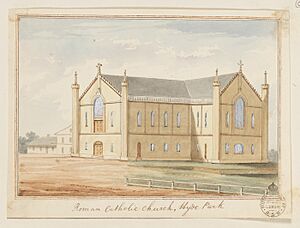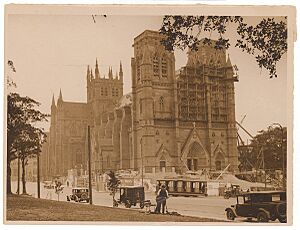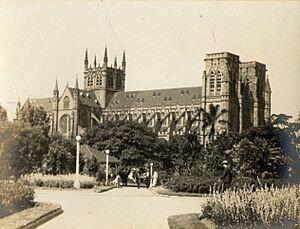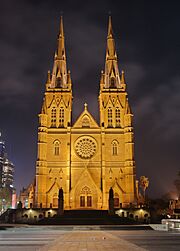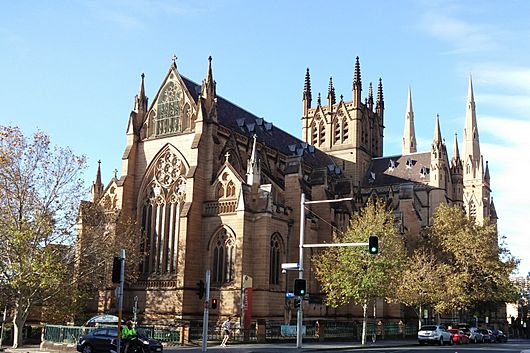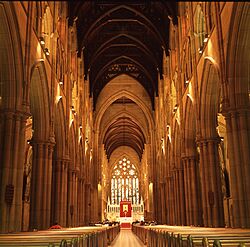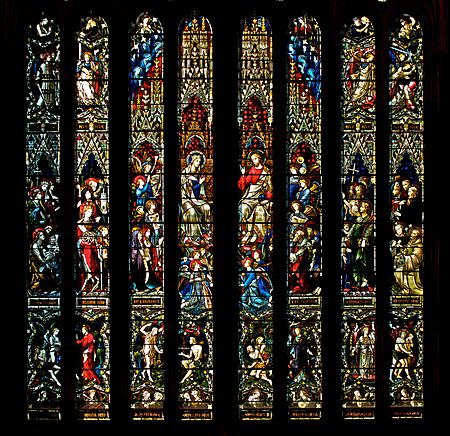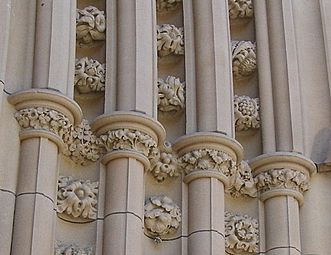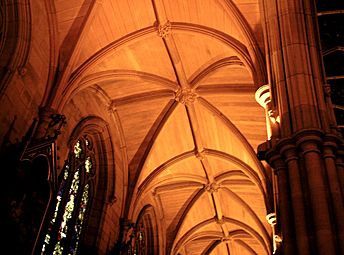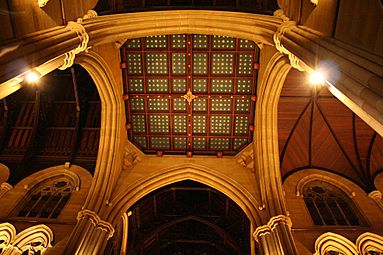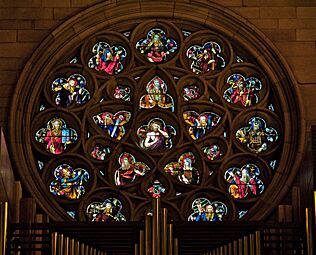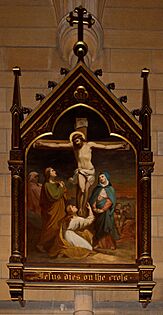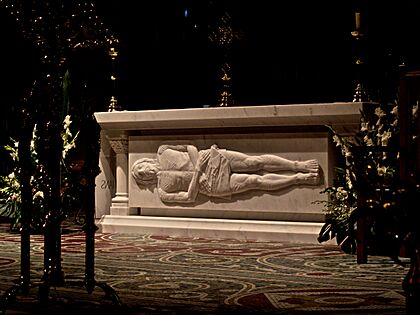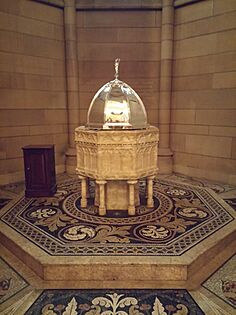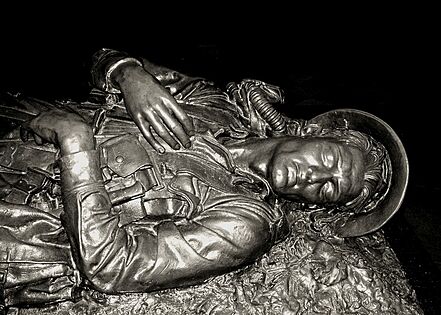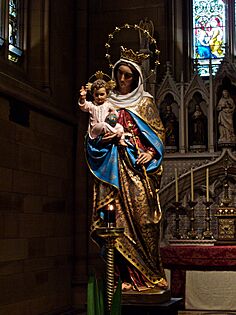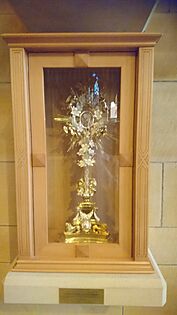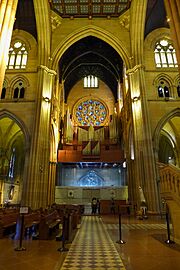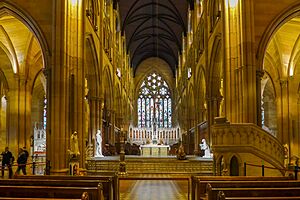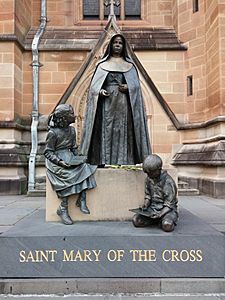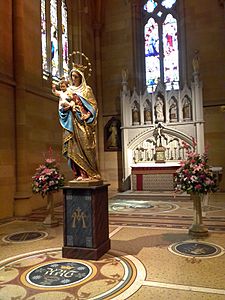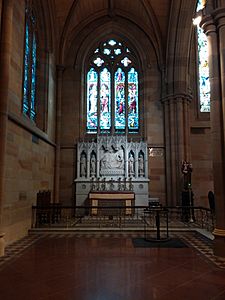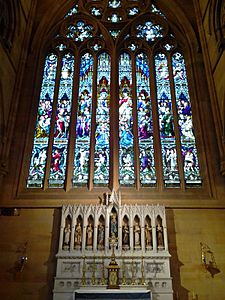St Mary's Cathedral, Sydney facts for kids
Quick facts for kids St Mary's Cathedral |
|
|---|---|
| Cathedral Church and Minor Basilica of the Immaculate Mother of God, Help of Christians, Patroness of Australia | |
| St Mary's Basilica | |

The cathedral from Hyde Park
|
|
| 33°52′16″S 151°12′48″E / 33.87111°S 151.21333°E | |
| Location | Sydney, New South Wales |
| Country | Australia |
| Denomination | Roman Catholic |
| History | |
| Former name(s) | St Mary's Chapel |
| Status | Minor basilica (since 1932) Cathedral (since 1835) Chapel (1821–1835) National shrine |
| Founded | 21 October 1821 |
| Dedication | Immaculate Conception, Mary Help of Christians |
| Dedicated | 29 June 1865 |
| Consecrated | 8 September 1882 |
| Relics held | First class relic of St Francis Xavier displayed, various others privately held |
| Events | Ruined by fire (29 June 1865) |
| Past bishop(s) | George Pell, Edward Clancy, John Bede Polding |
| Architecture | |
| Functional status | Active |
| Architect(s) |
|
| Architectural type | Chapel (first building) Cathedral (present building) |
| Style | Geometric Decorated Gothic |
| Years built | 1851 (first cathedral) 1928 (nave completed) 2000 (spires added) |
| Groundbreaking | 1821 (St Mary's Chapel) 1868 (present-day cathedral) |
| Specifications | |
| Length | 107 metres (351 ft) |
| Nave width | 24.3 metres (80 ft) |
| Nave height | 22.5 metres (74 ft) |
| Number of spires | 2 |
| Spire height | 74.6 metres (245 ft) |
| Materials | Sydney sandstone, Oamaru stone, marble, alabaster, Moruya granite |
| Bells | 14 |
| Tenor bell weight | 34 long cwt 1 qr 3 lb (3,839 lb or 1,741 kg) |
| Administration | |
| Parish | St Mary's |
| Deanery | City Deanery |
| Archdiocese | Metropolitan Archdiocese of Sydney |
| Metropolis | Sydney |
| Province | Sydney |
The Cathedral Church and Minor Basilica of the Immaculate Mother of God, Help of Christians, Patroness of Australia, usually called St Mary's Cathedral, is a very important church in Sydney, Australia. It is the main church for the Roman Catholic Archdiocese of Sydney and the home of the Archbishop of Sydney. The church is dedicated to the "Immaculate Mother of God, Help of Christians," who is the special protector of Australia. In 1932, Pope Pius XI gave it the special title of a minor basilica.
St Mary's is the longest church in Australia. You can find it on College Street, right next to Hyde Park in the heart of Sydney. Even with all the tall buildings around, the cathedral's impressive size and two tall spires make it easy to spot from far away. In 2008, St Mary's Cathedral was a main location for World Youth Day 2008. Pope Benedict XVI visited and blessed a new altar there. The famous architect William Wardell designed the cathedral, and it was built between 1866 and 1928. It is also known as St Mary's Catholic Cathedral and Chapter House. This historic building was added to the New South Wales State Heritage Register on 3 September 2004.
Contents
History of St Mary's Cathedral
How it all began
Sydney was started on 26 January 1788 as a place for prisoners sent from Britain. Many people who arrived were soldiers, some with families, and also some free settlers. The first church leader was Reverend Richard Johnson from the Church of England. However, there was no plan for the many Catholic prisoners and settlers. An Irish Catholic priest, Father O'Flynn, came to New South Wales, but he was sent back because he didn't have government permission.
It wasn't until 1820 that two priests, Father Conolly and Father John Therry, officially arrived to help Catholics in Australia. Father Conolly went to Tasmania, and Father Therry stayed in Sydney. Father Therry later said that on the day he arrived, he had a vision. He imagined a huge church made of golden stone, dedicated to the Blessed Virgin Mary, with two tall spires reaching above Sydney. This vision eventually came true, but it took over 180 years and three other buildings before the current cathedral was finished.
Building one church after another
Father Therry asked for land to build a church. He wanted land on the western side of Sydney, but he was given land to the east. This land was next to buildings that Governor Lachlan Macquarie was constructing, like the hospital and the Hyde Park Barracks. The site for the Catholic church looked out over an empty area where bricks for Macquarie's buildings were made. Today, this area is Hyde Park, with beautiful trees and the Archibald Fountain.
The first St Mary's church began with its foundation stone laid on 29 October 1821 by Governor Macquarie. James Dempsey built it. It was a simple stone church shaped like a cross, with pointed windows and towers that showed the popular Gothic style. In 1835, John Polding became the first Catholic archbishop in Australia. The church was changed in 1851 based on designs by Augustus Welby Pugin. Father Therry passed away on 25 May 1864. Sadly, on 29 June 1865, the church caught fire and was completely destroyed.
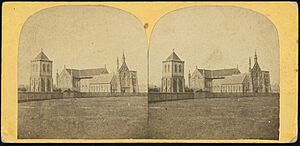
After the fire, Father McEnroe quickly started planning and raising money for the current cathedral. Archbishop Polding had drawn up a plan. Polding wrote to William Wardell, who was a student of Augustus Welby Pugin, a very famous architect of the Gothic Revival style. Polding was impressed with Wardell's work on St John's College at the University of Sydney. In his letter, Polding told Wardell he could design anything he wanted, saying, "Any plan, any style, anything that is beautiful and grand, to the extent of our power." Wardell had also designed St Patrick's Cathedral, Melbourne and started building it in 1858.
There were two temporary churches built after the first one burned down. A wooden church was built, but it also burned down in 1869. The third temporary church was a strong brick building. It was built on the site of St Mary's School and was used for the school long after the current cathedral was finished.
Building the grand cathedral
Archbishop Polding laid the foundation stone for the current cathedral in 1868. It was planned to be a huge and impressive building with a wide main area (nave) and side aisles, plus three towers. Polding did not live to see it finished, as he died in 1877. Five years later, on 8 September 1882, his successor, Archbishop Vaughan, led the dedication ceremony. Archbishop Vaughan gave the set of bells that were rung for the first time that day. Vaughan died in England in 1883.
The builder for this part of the cathedral was John Young. He also built a large sandstone house in the Gothic Revival style called "The Abbey" in Annandale, New South Wales.
But St Mary's was still not complete. Work continued under Cardinal Moran. In 1913, Archbishop Kelly laid the foundation stone for the nave, which was built by the architects Hennessy, Hennessy and Co. In 1928, Kelly dedicated the nave just in time for the 29th International Eucharistic Congress. If you look closely at the internal walls, you can see a slight difference in the color and texture of the sandstone. This shows where the first and second parts of the building meet.
After Prime Minister Joseph Lyons died in April 1939, his body rested at St Mary's for several days. Then, it was taken to his hometown of Devonport, Tasmania, for burial.
The cathedral continued to be decorated and improved. Archbishop Vaughan's remains were brought back to Sydney and buried in the Chapel of the Irish Saints. The beautifully decorated crypt, which holds the bodies of many early priests and bishops, was not finished until 1961. Cardinal Gilroy dedicated it then.
For many years, the two flat-topped towers at the front made the elegant building look unfinished. People often suggested adding smaller spires to match the central tower, as it seemed William Wardell's planned tall spires would never be built. However, with help from a government grant to celebrate the new millennium, the spires were finally completed in 2000.
Since 2000
On 16 December 2014, Archbishop Anthony Fisher led special prayers for the victims of the 2014 Sydney hostage crisis. A memorial service was held at the cathedral on 19 December for Tori Johnson and Katrina Dawson. Important guests, including the Governor-General Peter Cosgrove and the Premier of New South Wales Mike Baird, attended.
St Mary's Architecture
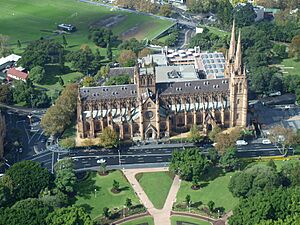
Building layout
St Mary's Cathedral is unusual because of its size and the way the city is built around it. It faces north-south instead of the usual east-west. This means the main altar (liturgical East End) is at the north, and the main entrance (West Front) is to the south.
The cathedral's layout is like a typical English cathedral. It's shaped like a cross, with a tower where the main aisle (nave) and side sections (transepts) meet. There are also two towers at the main entrance (south end). The area around the altar (chancel) is square, similar to churches like Lincoln and York in England. There are three main doors at the south end, and other entrances are conveniently placed in the transept walls. These lead from Hyde Park and from the buildings next to the cathedral.
Building style
The cathedral's style is typical of the Gothic Revival movement from the 1800s. It was inspired by old church designs and the writings of John Ruskin. When the foundation stone was laid, architect Edmund Blacket had just finished Sydney's smaller Anglican cathedral, St Andrew's, and the main building of Sydney University. St Mary's, once William Wardell's plan was built, was much larger and more impressive than St Andrew's. Because of its great location, it still stands out in many views of the city, even with all the modern high-rise buildings.
The cathedral's style is called Geometric Decorated Gothic. This means it looks like church buildings from late 13th-century England. It is very similar to Lincoln Cathedral, and the detailed window design of its huge chancel window is almost an exact copy of Lincoln's.
Outside the cathedral
When you look at the side of the building from Hyde Park, you'll see a regular pattern of Gothic windows with pointed arches and simple designs. The top of the roof has a decorative stone railing, broken by fancy gables above the upper windows (clerestorey). Above this is a steep slate roof with many small dormer windows, like those in French buildings. The roofline of the side aisles has carved decorations between the strong supports (buttresses) that hold up the upper walls.
The transept, facing Hyde Park, is the usual public entrance, just like in many French cathedrals. It has richly decorated doors. Unlike the main front doors, these have all their carved details finished. They show the amazing skills of local artists in designing and carving in the Gothic style. Among the leaf-like carvings, you can even find Australian native plants like the waratah, which is the flower symbol of New South Wales.
People usually walk to St Mary's Cathedral from the city through Hyde Park. From there, the transept front and central tower rise up behind the Archibald Fountain. Over the years, the gardeners of Hyde Park have made the view even better by creating a garden on the cathedral side of the park, often shaped like a cross.
Even though the cathedral has many English features, its main entrance (façade) doesn't look English at all. It's loosely based on the famous Gothic front of Notre Dame de Paris, with its balanced vertical and horizontal lines, three huge doorways, and a central rose window. There are two more large rose windows, one in each of the side sections (transepts). The French-style front was meant to have two tall stone spires, like those of Lichfield Cathedral, but they weren't added until 132 years after the building started.
The tower where the main aisle and side sections meet (crossing tower) holds the bells. It looks strong, but its shape is made elegant by tall, decorative pinnacles. The completed spires at the main front make the cathedral look even better along College Street and from the grand stairs in front of the building. Standing at 74.6 metres (245 ft), they make St Mary's the fourth tallest church in Australia.
Inside the cathedral
Inside, the cathedral is like most large churches. It has a tall central area (nave) and a side aisle on each side. These aisles help support the nave and provide walkways. The inside of the nave rises in three parts: the arches (arcade), the upper walkway (gallery), and the upper windows (clerestory) that let light into the nave.
The building is made of golden-colored sandstone, which has turned golden-brown on the outside over time. The roof is made of red cedar wood. The nave's roof has an open, arch-braced design with decorative carved patterns. The chancel (area around the altar) has a wooden vaulted ceiling. This was probably meant to be decorated with rich red, blue, and gold colors, but it wasn't. Instead, the warm color of the wood looks nice against the stone.
The side aisles have stone vaulted ceilings, with a large round carved decoration (boss) in the center of each ribbed section. Children who have explored the arched space under the pulpit have found another beautiful, tiny carved boss there, usually hidden from view. On all the ends of the arches inside the building, there are carved heads of saints. The ones near the confessionals are at eye-level, so you can see their details up close.
The screen behind the main altar is delicately carved from Oamaru limestone from New Zealand. It has spaces filled with statues, just like the similar spaces in the altar of Our Lady right behind it. There are two large chapels and two smaller ones. The larger ones are the Chapel of the Sacred Heart and the Chapel of the Irish Saints. On either side of the Lady Chapel are the Chapels of Ss Joseph and Peter. All of these have beautifully carved altars and a small statue in each space. The detailed mosaics on the floor of the Kelly Chapel were laid by Melocco Co. in 1937.
Lighting inside
Because Australian sunlight is very bright, it was decided during construction to use yellow glass in the upper windows (clerestory). This glass has gotten darker over the years, so not much light comes through. The yellow glass is different from the mostly blue stained glass in the lower windows. To make up for the darkness, the cathedral installed many lights in the 1970s. These lights were designed to light up all parts of the building evenly. The inside has a soft yellow glow, which, like the upper windows, is different from how natural light would usually create patterns of light and shadow in a Gothic cathedral. The installed lighting makes the whole space bright, even areas that would normally be darker.
Stained glass windows
All the stained glass in the cathedral was made by Hardman & Co. over about 50 years.
There are about 40 windows with pictures that tell different stories. The most important is the chancel window, which shows the Fall of Man and Mary, crowned and on a throne next to Jesus as he judges, asking for Jesus' mercy on Christians.
Other windows show the stories of the rosary, the birth and childhood of Jesus, and the lives of the saints. The style of the windows changes from the Gothic Revival of the 1800s to a more artistic and rich style of the early 1900s.
- Details of the architecture
-
Western transept rose window.
Treasures of the Cathedral
St Mary's is filled with many beautiful and special items. Along the walls of the side aisles are the Stations of the Cross. These are paintings in oil by L. Chovet of Paris, chosen for St Mary's by Cardinal Moran in 1885. In the western transept, there is a marble copy of Michelangelo's famous Pietà. The original is in St. Peter's Basilica in Rome. This sculpture was brought to Australia for display in a department store and later given to the cathedral.
The crypt, which is a special underground area, has an amazing mosaic floor. This floor was created by Peter Melocco and his company. The design is based on a cross, decorated like a huge Celtic illuminated manuscript. It includes round pictures showing the Days of Creation and titles of the Virgin Mary.
- Treasures of the cathedral
-
Crucifixion from the Stations of the Cross by L. Chovet.
-
Decoration of the Low Altar includes a sculpture of Jesus' body, based on the Shroud of Turin.
Music at St Mary's
The music team at St Mary's includes the acting director of music, Simon Niemiński, and assistant organists Callum Knox and Dominic Moawad. Eleanor Taig is the music administrator.
Pipe organs
- The first pipe organ in the original cathedral was built by Henry Bevington of London and installed in June 1841. It had two keyboards and 23 stops, making it the largest organ in Australia until it was destroyed by fire in 1865.
- In 1942, a pipe organ built by Joseph Howell Whitehouse of Brisbane was installed in the gallery above the main door.
- Between 1959 and 1971, Ronald Sharp started installing an electric organ in the upper gallery of the sanctuary, but it was never fully completed.
- In 1997, a new pipe organ was built by Orgues Létourneau of Quebec, Canada. It was installed on a new gallery built around the rose window in the western transept. It was finished in 1999 and dedicated by Cardinal Clancy. The Létourneau organ has three keyboards and 46 stops. It can be played from the gallery or from a movable electronic console on the main floor, which also controls the Whitehouse organ.
- A small organ by Henk Klop is in the Irish Saints' chapel and is used for evening prayers (vespers) on weekdays.
- There is a digital organ in the choir area, used for daily choir services.
- An organ made by Bellsham Pipe Organs (1985) is in the crypt.
Choirs
There are two choirs that sing during church services at the cathedral. The Cathedral Choir sings almost every day. There is also a choir of adult volunteers, the St Mary's Singers, who sing regularly for services and sometimes for concerts.
St Mary's Cathedral Choir
The St Mary's Cathedral Choir started in the 1800s with mixed voices. Since 1955, it has been a traditional English-style cathedral choir of men and boys. Usually, there are 24 boy choristers (singing high parts) and 12 adult lay clerks (professional singers for lower parts). The choir sings Mass and Vespers daily (except Fridays) and is the oldest continuous music group in Australia. They perform many types of music, from old Gregorian Chant and Sacred Polyphony to modern songs.
Cathedral Scholars
Boy choristers from the Cathedral Choir whose voices have changed continue their training in this special group. The Scholars sing Vespers and Mass on Wednesdays and Saturdays.
St Mary's Singers
The St Mary's Singers is an adult choir of volunteer mixed voices. They sing for Vespers and Mass on the third Saturday of every month, as well as for other church events and regular concerts.
Bells of St Mary's
The bells of St Mary's Cathedral have a special place in Australian history. There have been three different sets of bells at the cathedral, all made by the Whitechapel Bell Foundry in London. The first set of eight bells arrived in Sydney in August 1843. They were placed in a wooden bell tower (campanile) away from the main building. These were the first bells in Australia set up for change ringing (a special way of ringing bells). They rang for the first time on New Year's Day 1844. When the cathedral burned down in June 1865, the bells were not damaged. Building of the new cathedral began in 1866. In 1868, the bells were moved from the wooden tower to the new stone tower. In 1881, these bells were traded for a new set of eight, which were installed the next year. In 1885, a contract was signed to build the Central Tower (the Moran Tower), and the bells were moved there in 1898.
A century later, a completely new set of bells was ordered. Today, the Central Tower has a set of twelve bells, plus two extra bells. These extra bells allow different groups of bells to be rung, depending on how many bell ringers are available and their skill. They were rung for the first time in 1986. Seven bells from the 1881 set are now part of a set of twelve bells at St Francis Xavier Cathedral in Adelaide. The old largest bell (the Moran Bell) became the Angelus bell and is now in St Mary's south-eastern tower. The bells are rung regularly before the main Mass on Sundays and on important feast days. They are also rung for weddings, funerals, and important public events. The bells of St Mary's led the ringing that marked 100 years of Australian Federation. They are also rung as part of the end of Sydney's Symphony in the Domain concert in January, playing along with Tchaikovsky's 1812 Overture. The St Mary's Basilica Society of Change Ringers takes care of ringing the bells. They are members of The Australian and New Zealand Association of Bellringers.
Why St Mary's is important
St Mary's Cathedral is a very important historical site. It is the oldest place in Australia that has continuously been used for Catholic worship. It's where the first Catholic church in Australia stood, and it was the first land given to the Catholic Church in Australia. It's also the oldest place where Catholic priests have lived permanently. Because of all this, St Mary's Cathedral can be called the birthplace of Catholicism in Australia.
The cathedral is connected to many important people in the history of the Catholic Church in Australia. These include Father Therry, archbishops Polding and Vaughan, Cardinal Moran, and Archbishop Kelly. It's also linked to important people from the 1800s and 1900s, like governors Macquarie and Bourke, and architects Greenway, Pugin, Wardell, and Hennessy. The cathedral is the main church for the Archbishop of Sydney and the mother church for all of Australia.
The cathedral is also very important for its architecture. It is the largest church built in the 1800s in the English Gothic style anywhere in the world. The Cathedral Chapter Hall, located to the east, is the oldest building still standing on the site. It might be the oldest Catholic school building still around in Australia. It also shows that Pugin himself was directly involved in its design.
St Mary's Catholic Cathedral was added to the New South Wales State Heritage Register on 3 September 2004 because it met several important criteria.
Historical importance
The cathedral site is the oldest place in Australia that has continuously been used for Catholic worship. It's where the first St Mary's Cathedral, Australia's first Catholic church, stood before it burned down in 1865. This site is important because it was the first land given to the Catholic Church in Australia. Governor Macquarie laid the foundation stone for the first St Mary's here, which shows how the Catholic Church and the Australian government came together. The site of St Mary's Cathedral is also important as the oldest permanent home for Catholic priests in Australia. For these reasons, it's considered the birthplace of Catholicism in Australia.
The International Eucharistic Congresses of 1928 and 1954 were held at St Mary's. It's also where the first Pope to visit Australia celebrated Mass. Through its organists and choirs, the cathedral has played a big part in Sydney's music history. The Cathedral Chapter Hall, to the east, is the oldest building still on the site. It might be the oldest Catholic school building still standing in Australia. The Chapter Hall has been used continuously as a school and general hall, and it was an important early public meeting place.
Important people and groups
The cathedral is linked to important figures in Australian Catholic history, such as Father Therry, Archbishops Polding and Vaughan, Cardinal Moran, and Archbishop Kelly. All of them are buried in the crypt. It's also connected to important people from the 1800s and 1900s, including Governors Macquarie and Bourke, and architects Greenway, Pugin, Wardell, and Hennessy. The Chapter Hall's Gothic Revival style fits well with the cathedral and looks very pleasing.
Beautiful design and achievements
The cathedral is located on a ridge on the eastern edge of the city center. It looks grand and inspiring, with its roof and towers rising above nearby buildings and trees. Its cross shape connects it to the harbor, Woolloomooloo, Hyde Park, and College and Macquarie Streets. The long English design of the building strongly connects the cathedral to the city. From inside, the cathedral offers beautiful views of the surrounding city. It is the largest 19th-century church in the English Gothic style anywhere in the world. Its design and details are of the highest quality. Along with St Patrick's Cathedral in Melbourne, St Mary's is the most important church designed by William Wardell, a famous Gothic Revival architect who worked in Australia. The cathedral holds many beautiful items, from stained glass windows to altars, statues, and mosaics. It's also an important place for musical events and plays a big role in bell ringing in Australia.
Community connection
St Mary's Cathedral is the main church for the Archbishop of Sydney and the mother church for all of Australia. Its physical presence and spiritual meaning show the Catholic faith. It is mainly a place for sacraments, prayer, and worship. It is also a great public building important to all people in Sydney. Built on the site of the first official Catholic church in the colony, the current cathedral complex connects back two centuries, without interruption, to the very start of the Catholic faith in Australia. It is a central point for the Catholic community of Australia. Through its music and other artistic activities, it is also an important part of Sydney's cultural life.
Learning from the building
As a major sandstone building in Sydney, the cathedral's physical structure shows the high quality of craftsmanship, engineering skill, and local style achieved in sandstone buildings in Victorian Sydney. The completion of the southern front of the cathedral by Hennessy Hennessy and Co. shows new building technology from the early 1900s, especially in how the foundations and crypt were built.
Unique features
St Mary's is a rare example of a 19th-century Gothic-style Catholic cathedral. The chapter hall is the only remaining building directly linked to John Bede Polding, the first Archbishop of Australia.
Key characteristics
St Mary's Cathedral and Chapter House has been the center of Catholic worship and culture in Sydney (and arguably the state) since it was built in the 1870s.
Images for kids
-
Statue of St Mary of the Cross at the College Street doors.
-
Chapel of the Irish Saints with an altar screen showing the Crucifixion, with statues of St Patrick and Brigid of Ireland.
-
The special clothes (vestments) of St Oliver Plunkett, Archbishop of Armagh.
-
Statue of Saint Patrick given to the cathedral by a Catholic society.
Burials in the crypt
- John Bede Polding
- Roger Bede Vaughan
- Patrick Francis Moran
- Michael Kelly
- Norman Thomas Gilroy
- James Darcy Freeman
- Edward Clancy
- Edward Cassidy
- John Therry, first official colonial chaplain
- John McEncroe, second official colonial chaplain
- Daniel Power
- Charles Davis, Bishop of Maitland and coadjutor bishop of Sydney
- George Pell
See also
 In Spanish: Catedral de Santa María (Sídney) para niños
In Spanish: Catedral de Santa María (Sídney) para niños
- St Mary's Cathedral College, Sydney
- St. Andrew's Cathedral, Sydney, the Anglican cathedral
- The Domain, Sydney, to the north-east



